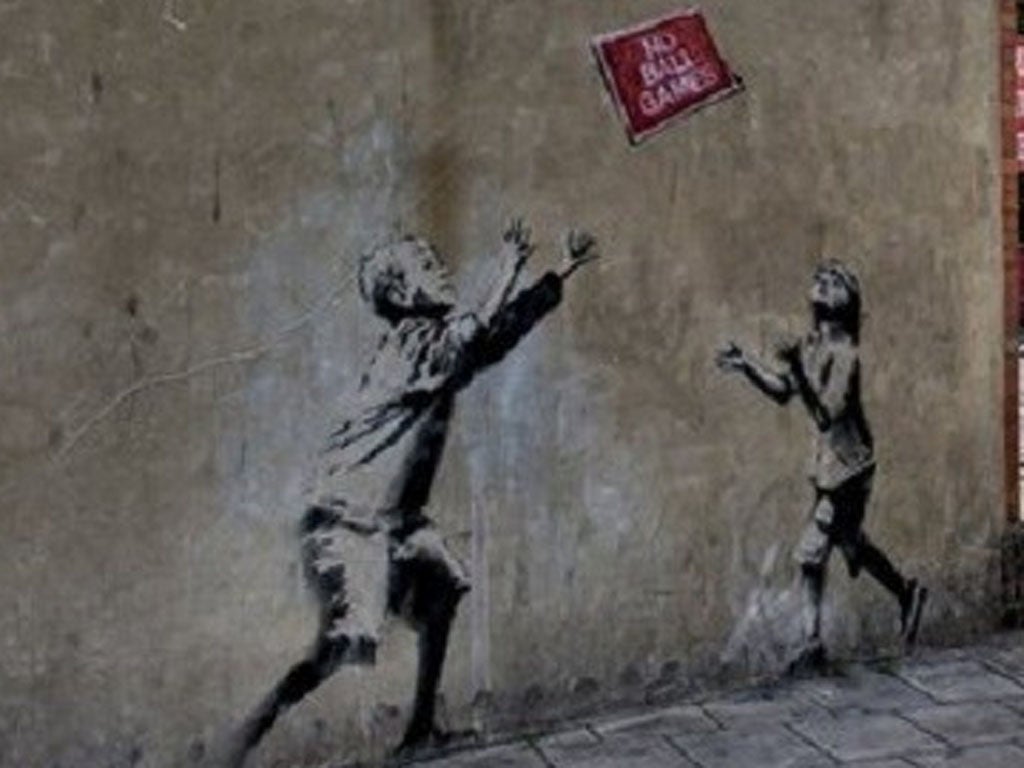No Ball Games: Removing Banksy’s work from the street defeats the point
The nature of murals and wall sculptures ordinarily meant that the work of art was forever tied to its original location

Your support helps us to tell the story
From reproductive rights to climate change to Big Tech, The Independent is on the ground when the story is developing. Whether it's investigating the financials of Elon Musk's pro-Trump PAC or producing our latest documentary, 'The A Word', which shines a light on the American women fighting for reproductive rights, we know how important it is to parse out the facts from the messaging.
At such a critical moment in US history, we need reporters on the ground. Your donation allows us to keep sending journalists to speak to both sides of the story.
The Independent is trusted by Americans across the entire political spectrum. And unlike many other quality news outlets, we choose not to lock Americans out of our reporting and analysis with paywalls. We believe quality journalism should be available to everyone, paid for by those who can afford it.
Your support makes all the difference.Last week another one of Banksy’s works entitled 'No Ball Games', was removed from the streets of Harringey. The Sincura Group, also behind the sale of Banksy’s 'Slave Labour' last month, are the company responsible for this act of “salvage” intend to restore the work, which has been subject to vandalism and then donate the profits of the following sale to Step by Step, a local charity for disabled children.
I don’t wish to cast a cynical eye over how genuinely compassionate the actions of the Sinucra group may be. Nor enter the argument of whether the gain to Haringey’s children justifies the loss to its art scene. Indeed there’s even something quite poetic about an artwork depicting children at play being sold to help actual disadvantaged children. But what can’t be denied is, however honourable the actions of the Sinucra group, however much the money will help the charity and whether or not the artwork will end up back in public hands, the work’s impact and meaning will be lost because of its removal.
The nature of murals and wall sculptures ordinarily meant that the work of art was forever tied to its original location. It might have been vandalised or painted over but unlike a painting or stand-alone sculpture it would not be moved. 'The Last Supper' still remains in an otherwise unremarkable convent in Milan. Importantly in the Sistine Chapel, you still look up to the heavens to see God. Of course exceptions apply such as the pillage of the Parthenon marbles by Lord Elgin in the early 19th century, a matter of continued controversy. That removal greatly damaged the beauty and magic of the marbles. Sincura’s removal of Banksy’s works should also be viewed as an act of aesthetic damage.
To understand what Sincura do to Banksy, just look at the exhibited New Slaves compared to the original on the side of a Poundland store in Wood Green. The pain of the boy’s legs can no longer be felt as they no longer rest on hard pavement but rather on a garish frame suspended in space. The bunting he sews no longer stretches up to become actual bunting on an actual street but hangs limply, disconnected from reality. The direct link between the UK textile industry and third-world sweatshops is lost.
Also consider the size and place of the artwork. In its initial home, at ground level, it was deliberately diminutive. It occupied a small space of a large wall suggesting the boy’s unimportance; his underrepresented suffering. In an art gallery, Sincura promises that the work will be one of three centrepieces at its exhibition next year. People will glare at the boy, now elevated to eye level, now equal when the whole point was precisely that he was representative of the silent masses of sweatshop workers. That on a first walk down that street in Wood Green you’d stop and stare and maybe take a photo but only whilst locals and commuters strolled by without a second glance. It’s a pertinent message in an age that saw Joseph Kony rise meteorically and then collapse from the public agenda. It’s a message lost by framing the work in a gallery.
Similarly, in my opinion, 'No Ball Games' has been somewhat destroyed by Sincura’s removal. It’s sadly ironic that a work presenting the liberation of childhood and of outdoor play, shall be moved indoors to a mood-lit cellar in Covent Garden (if Sincura’s 2013 exhibition venue is anything to go on). And as with 'Slave Labour', who’s to say how big the mural is. Unlike a painting which is bound by its frame, a mural’s boundaries are unknown.
The children in 'No Ball Game' throw the sign up to the sky, not to the top of their artificially enclosed picture frame. Ultimately, removing Banksy’s works from the street removes so much of what is unique and captivating about street art, particularly its engagement with location. Sincura’s intentions may be compassionate but their actions are disastrous. As Grayson Perry said when 'Slave Labour' was removed for restoration: "The very fact that they were trying to preserve it actually destroyed it."
Join our commenting forum
Join thought-provoking conversations, follow other Independent readers and see their replies
Comments